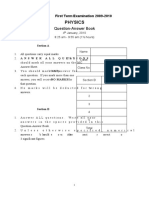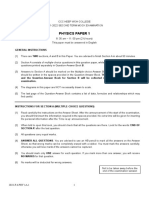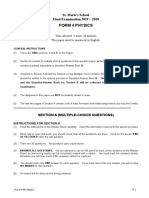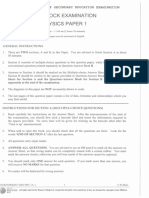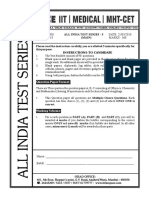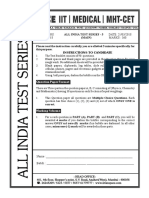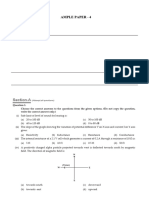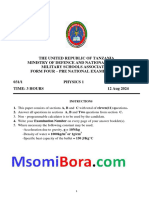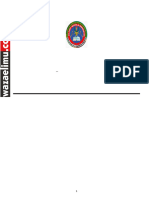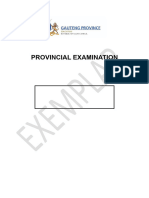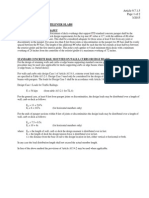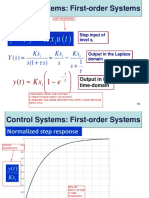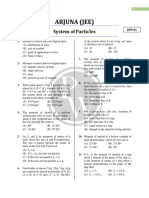F4 PhMid 1A 19
F4 PhMid 1A 19
Uploaded by
pg7rrnqw9fCopyright:
Available Formats
F4 PhMid 1A 19
F4 PhMid 1A 19
Uploaded by
pg7rrnqw9fOriginal Title
Copyright
Available Formats
Share this document
Did you find this document useful?
Is this content inappropriate?
Copyright:
Available Formats
F4 PhMid 1A 19
F4 PhMid 1A 19
Uploaded by
pg7rrnqw9fCopyright:
Available Formats
ST. PAUL'S COLLEGE F.
4 Mid-year Examination 2019-2020
PHYSICS
( 2 hours )
Name
Class
Class No.
Subject Teacher Mr. Kwok / Ms. Chan
GENERAL INSTRUCTIONS
1. Write your Name, Class and Class Number in the spaces provided on this cover. Circle the na
me of your subject teacher.
2. Answer ALL questions in this Paper.
3. There are TWO sections, A and B, in this Paper.
SECTION A: Multiple-choice Questions (28 questions)
Questions are printed in this question book. Answers to Section A should be marked on the Mult
iple-choice Answer Sheet.
SECTION B: Structural Questions (68 marks)
Questions are printed separately in Question-Answer Book B. Answers to Section B should be
written in the spaces provided in Question-Answer Book B.
4. Sections A and B carry 35% and 65% respectively. The Multiple-choice Answer Sheet and the Quest
ion-Answer Book B for Section B must be handed in separately at the end of the examination.
SECTION A (MULTIPLE-CHOICE QUESTIONS)
INSTRUCTIONS FOR SECTION A
1. All questions carry equal marks.
2. ANSWER ALL QUESTIONS. You should use an HB pencil to mark all your answers on the
Answer Sheet. Wrong marks must be completely erased.
3. You should mark only ONE answer for each question. If you mark more than one answer, you
will receive NO MARKS for that question.
4. No marks will be deducted for wrong answers.
F.4 Physics 1A Mid-year Exam 19-20 Page - 1
There are 28 questions. The back cover of this question paper contains a list of data, formulae a
nd relationships which you may find useful.
1. A straight bimetallic strip is heated in a flame as shown.
metal A
Bunsen metal B
burner
The strip bends downwards when heated. Which of the following statements must be correct ?
(1)Metal A expands more than metal B when they are heated.
(2)Metal A have a lower density than metal B.
(3)The strip bends upwards when it is cooled to far below room temperature.
A. (1) only B. (2) only
C. (1) and (2) only D. (1) and (3) only
2. Which of the following statements must be correct ?
(1)Internal energy is the energy gained by an object as a result of heat flow.
(2)Heat is the energy transferred from one body to another as a result of a temperature differe
nce between the bodies.
(3)Temperature measures the energy transferred from one object to another when the objects
are in contact.
A. (2) only B. (1) and (2) only
C. (1) and (3) only D. (1), (2) and (3)
3. A heater is used to heat each of the following blocks for the same period of time. Which block
has the highest specific heat capacity ?
Block Mass Increase in Temperature
A. W m/4 4T
B. X m/2 T
C. Y 2m 2T
D. Z 4m T/2
4. A heater immersed in water is connected to a kilowatt-hour meter. It is found that 0.2 kW h is
used by the heater in 2 hours. If half of the energy is lost to the surroundings, what is the total
energy gained by the water ?
A. 50 J B. 200 J
C. 360 kJ D. 720 kJ
F.4 Physics 1A Mid-year Exam 19-20 Page - 2
5. The specific heat capacity of ice and water are 2100 J kg−1 °C−1 and 4200 J kg−1 °C−1 respective
ly. Which of the following statements is/are correct ?
(1)The heat required to raise the temperature of ice by 1 °C is greater than that of water.
(2)The heat removed when the temperature of ice decreases by 1 °C is smaller than that of w
ater.
(3)When ice of 1 kg at −10 °C is mixed with water of 1 kg at 5 °C, the temperature of the m
ixture is higher than 0 °C.
A. (2) only B. (1) and (2) only
C. (1) and (3) only D. (2) and (3) only
6. The apparatus below is used to find the specific latent heat of vaporization of water.
Which of the following factors will make the result obtained smaller than the true value ?
(1)Some energy supplied by the heater is lost to the surroundings.
(2)Some water splashes out of the cup as it boils.
(3)Some steam condenses and drips back into the cup.
A. (2) only B. (1) and (2) only
C. (1) and (3) only D. (1), (2) and (3)
7. A beaker of liquid has the same temperature as the surroundings. When the liquid evaporates,
which of the following statements concerning the molecules in the liquid is correct ?
A. The potential energy of the molecules increases.
B. The potential energy of the molecules decreases.
C. The total internal energy of the molecules increases.
D. The total internal energy of the molecules decreases.
8. There are 3 beakers of identical shape holding the same amount of hot water at 60 °C. Beaker
X is uncovered. Beaker Y is covered. Beaker Z is uncovered and is painted black (Figure a).
Y X Z
Figure a
The variation of their temperatures T with time t is shown in Figure b.
F.4 Physics 1A Mid-year Exam 19-20 Page - 3
T / C
60
A
B
30 C
0 t / min
Figure b
Which of the following statements is/are correct ?
(1) Curve A corresponds to beaker Z.
(2) Curve B corresponds to beaker X.
(3) The room temperature is 30 C.
A. (3) only B. (1) and (3) only
C. (2) and (3) only D. (1), (2) and (3)
9. Which of the following is/are incorrect ?
(1) Distance is a vector which has both magnitude and direction.
(2) Displacement is a vector which has both magnitude and direction.
(3) Speed is a scalar which has magnitude only.
(4) Time is a vector which has both magnitude and direction.
A. (1) only B. (1) and (4) only
C. (1), (2) and (3) only D. None of the above
10. A minibus starts from rest and speeds up at 2 m s–2 for 2 s along a straight road. Then it
slows down at 0.3 m s–2 for 1 s. What is the final speed of the minibus ?
A. 1.7 m s–1 B. 2.3 m s–1
C. 3.7 m s–1 D. 4.3 m s–1
11. A stone is released from a certain height above a planet’s surface. It falls a distance of
7.5 m during the first 3 s. What distance it will fall during the first 6 s ?
A. 15 m B. 30 m
C. 45 m D. 60 m
12. A ball is thrown vertically upwards with an initial velocity of 15 m s-1. An equation of
motion is used to calculate the time taken for the ball to move to a displacement of 15
m. Which of the following expressions shows a correct substitution of appropriate valu
es ?
A. 15 15t 9.81t2 B. 15 15t 9.81t2
C. 15 15t 9.81t2 D. 15 15t 9.81t2
F.4 Physics 1A Mid-year Exam 19-20 Page - 4
13. A car travels along a straight road. It first accelerates from rest, then travels at a consta
nt velocity, then decelerates to a stop. It then remains at rest. Which graph below best
represents the displacement s of the car as a function of time t ?
14. acceleration / m s2
10 16
2
0 time / s
1
A car travels along a straight road. The figure shows its accelerationtime graph, taking its mo
ving direction as positive. If the car’s velocity is 54 km h1 at t = 0, which of the following stat
ements is/are correct ?
(1) The car’s velocity is 68 km h1 at t = 16 s.
(2) The car’s average acceleration in these 16 seconds is 0.875 m s2.
(3) The car changes its moving direction at t = 10 s.
A. (1) only B. (2) only
C. (1) and (3) only D. (1), (2) and (3)
15. A ball is dropped from rest and allowed to bounce several times. The graph shows how
the velocity of the ball varies with time. Which of these statements is/are correct ?
F.4 Physics 1A Mid-year Exam 19-20 Page - 5
(1) The ball hits the ground at P.
(2) The ball is moving upwards between Q and R.
(3) The ball is moving upwards between R and S.
A. (1) only B. (2) only
C. (3) only D. (1) and (2) only
16. A horizontal force F acts on a box which is placed on the floor as shown.
F box
floor
The variation of F with time t is shown in the figure below.
F
If the box does not move, which of the following figures best shows the variation of the magnit
ude of the friction f with time t ?
A. B. f f t t
C. D. f f t t
17. Two boxes X and Y are pushed to move on a rough horizontal surface by a force of 60
N as shown in figure below. The masses of X and Y are respectively 3 kg and 5 kg. Bo
th boxes move with constant velocity. The friction acting of Y is twice that acting on X.
F.4 Physics 1A Mid-year Exam 19-20 Page - 6
60 N Y
X
What is the magnitude of the force acting on X by Y ?
A. 20 N B. 30 N
C. 40 N D. 60 N
18. In the following figure, a trolley of mass M is put on a horizontal table. A block of mas
s m is connected to the trolley by an inextensible string over a smooth pulley. When th
ey are released, they move with accelerations of the same magnitude a .
a
M
Which of the following expressions gives the friction acting on the trolley ?
mg
A. B. g (M + m) ma
M ma
C. mg (m M) a D. mg (m + M) a
19. Three forces act on a particle such that the particle remains stationary. The figure belo
w shows two of the forces.
particle
Which of the following arrows best represents the third force ?
B
C
A D
F.4 Physics 1A Mid-year Exam 19-20 Page - 7
20. In the figure below, a ball of mass m suspended by two strings remains stationary. The
tensions in the strings are T1 and T2. The acceleration due to gravity is g .
60 30
T1 T2
Which of the following is/are correct ?
(1) T1 cos 60 = T2 cos 30
(2) T1 sin 60 + T2 sin 30 = mg
(3) The resultant force of T1 and T2 is equal to mg and points vertically upwards.
A. (3) only B. (1) and (2) only
C. (2) and (3) only D. (1), (2) and (3)
21.
A man pulls a box of mass 50 kg and the box accelerates at 1 m s2 up the rough slope. The fri
ction acting on the box is 60 N. The string makes an angle of 40 to the horizontal and its ten
sion is T. The slope is inclined at 30 to the horizontal. Find the tension T.
A. 361 N B. 431 N
C. 543 N D. 698 N
22.
F.4 Physics 1A Mid-year Exam 19-20 Page - 8
A weight is hanged on one side of a light lever. Forces F1 and F2 are applied in turn at position
s (1) and (2) respectively so that the lever is balanced in both cases. Which of the followings is
correct ?
A. The magnitude of F1 > the magnitude of F2 and they are in the same direction.
B. The magnitude of F1 > the magnitude of F2 and they are in opposite directions.
C. The magnitude of F1 < the magnitude of F2 and they are in the same direction.
D. The magnitude of F1 < the magnitude of F2 and they are in opposite directions.
biceps
F
metal ball
forearm
C C'
elbow joint
4 cm
15 cm
34 cm
23.
The figure shows a human arm. The forearm and the hand have a total mass of 1.5 kg and thei
r centre of gravity C is 15 cm from the elbow joint. Suppose the hand holds a metal ball of ma
ss 5 kg. The centre of gravity C ' of the metal ball is 34 cm from the elbow joint. A force F ap
plied by the biceps 4 cm from the elbow joint holds the forearm at right angles to the arm. Find
the magnitude of F.
A. 360 N B. 410 N
C. 470 N D. 550 N
24. Peter is standing 4 m in front of a plane mirror. A lamp is located midway between Peter and t
he mirror. If Peter wants to take a sharp photo of the image of the lamp, at what distance shoul
d he focus ?
A. 2m B. 4m
C. 6m D. 8m
25. Which of the following statements about total internal reflection of light is/are correct ?
(1)It occurs only when light travels from glass to air.
(2)It will never occur if light travels from air to glass.
(3)It will occur if light travels from a medium with refractive index of 1.6 to air and the angl
e of incidence is greater than 39.
A. (1) only B. (3) only
C. (1) and (2) only D. (2) and (3) only
26. Rays of red and blue light enter medium II from a medium I
as shown. Which of the following statements is/are correct ?
F.4 Physics 1A Mid-year Exam 19-20 Page - 9
(1)Y shows blue light.
(2)Y has a lower speed than X in medium I.
(3)Medium I is less dense than medium II.
A. (1) only B. (3) only
C. (1) and (2) only D. (1) and (3) only
27. A lens is put under the sun and a match placed at 3 cm underneath the lens is lit. Which of the
following statements is/are correctly deduced from the situation ?
(1)The lens must be a convex lens.
(2)The focal length of the lens is 1.5 cm.
(3)The image of the sun formed by the lens is a point image (of no definite size).
A. (1) only B. (2) only
C. (1) and (2) only D. (1) and (3) only
28. A lens is placed in front of an object. The focal length of the lens is 12 cm. A virtual magnifie
d image is formed at a distance of 10 cm from the lens. Which of the following lenses is used
and what is the object distance ?
Type of lens Object distance
A. convex 5.5 cm
B. convex 60 cm
C. concave 5.5 cm
D. concave 60 cm
END OF SECTION A
F.4 Physics 1A Mid-year Exam 19-20 Page - 10
List of data, formulae and relationships
Data
speed of light in vacuum c = 3.00 x 108 ms-1 acceleration due to gravity
g = 9.81 m s-2 (Close to the Earth)
Rectilinear motion
For uniformly accelerated motion :
v u at
1
s ut at2
2
v u 2as
2 2
Mathematics
Equation of a straight line ymxc
Arc length r
Surface area of cylinder 2rh 2r2
Volume of cylinder r2h
Surface area of sphere 4r2
Volume of sphere r3
For small angles, sin tan (in radians)
EmcT energy transfer during
A1. heating and cooling
energy transfer during
A2. Em change of state
F m v p t
B1. force
t
B2. Moment = F × d moment of a force
111 equation for a single l
C3. u v f ens
F.4 Physics 1A Mid-year Exam 19-20 Page - 11
You might also like
- 06 Matter As ParticlesDocument10 pages06 Matter As ParticlesmahinkamNo ratings yet
- Process Modelling and Simulation - IntroductionDocument40 pagesProcess Modelling and Simulation - Introductiondppriya1984100% (5)
- Electronics MCQ'sDocument66 pagesElectronics MCQ'shassan0% (2)
- Carl Becker What Are Historical FactsDocument15 pagesCarl Becker What Are Historical FactssergevictorNo ratings yet
- Physics: Question-Answer BookDocument16 pagesPhysics: Question-Answer Bookjonas hoNo ratings yet
- Sing Yin Secondary School First Term Test, 2019 - 2020 PhysicsDocument4 pagesSing Yin Secondary School First Term Test, 2019 - 2020 PhysicstestNo ratings yet
- F.4 Phy Mock Paper (Paper 1A)Document13 pagesF.4 Phy Mock Paper (Paper 1A)Silly Ben bbNo ratings yet
- Elegantia College (Sponsored by Education Convergence) Second Term Examination (2018 - 2019) Form 5 Combined Science - Physics (Section A)Document10 pagesElegantia College (Sponsored by Education Convergence) Second Term Examination (2018 - 2019) Form 5 Combined Science - Physics (Section A)edmond 黃No ratings yet
- 14-15 3A Test On Temperature, Heat and Internal Energy ?Document4 pages14-15 3A Test On Temperature, Heat and Internal Energy ?s192438No ratings yet
- 1920 F4 Physics Final ExamDocument23 pages1920 F4 Physics Final ExamEvelyn ChongNo ratings yet
- 2MT Revision Practice 5Document25 pages2MT Revision Practice 5Sara -No ratings yet
- 08 F3 Final Exam With AnswerDocument20 pages08 F3 Final Exam With Answerjonas hoNo ratings yet
- F5 Phy Final 1A 22-23Document13 pagesF5 Phy Final 1A 22-23s20139No ratings yet
- TDocument12 pagesTholdonpainendsNo ratings yet
- F3 1st ExamDocument10 pagesF3 1st ExamgamecenreyaNo ratings yet
- F5 - Phy - Final - 1A - 21-22 2Document15 pagesF5 - Phy - Final - 1A - 21-22 2s20139No ratings yet
- Fiitjee - Jee (Main) : Physics, Chemistry & Mathematics Phase-4Document13 pagesFiitjee - Jee (Main) : Physics, Chemistry & Mathematics Phase-4Abhinav GuptaNo ratings yet
- 2010 S4 E1Document17 pages2010 S4 E1AjayNo ratings yet
- Phy Eng Paper 1A v4 Final PDFDocument16 pagesPhy Eng Paper 1A v4 Final PDFHuson 0710No ratings yet
- STFA Tam Pak Yu College Summer Supplementary Exercise S. 4 PhysicsDocument13 pagesSTFA Tam Pak Yu College Summer Supplementary Exercise S. 4 PhysicsMola MolaNo ratings yet
- F4 Final Exam 2122Document19 pagesF4 Final Exam 21225B04 CHOW HOI LAMNo ratings yet
- F4 1819 Final ExamDocument18 pagesF4 1819 Final Exam5B04 CHOW HOI LAMNo ratings yet
- Form 3 Final Examination 2007-2008 17th June 2008 8:25 Am Question-Answer BookDocument15 pagesForm 3 Final Examination 2007-2008 17th June 2008 8:25 Am Question-Answer Bookjonas hoNo ratings yet
- CW Mock 2017Document74 pagesCW Mock 2017Cardry MusicNo ratings yet
- Practice Paper Physics Paper 1Document69 pagesPractice Paper Physics Paper 1hNo ratings yet
- BCECE Physics Question Paper 2015 PDF DownloadDocument37 pagesBCECE Physics Question Paper 2015 PDF Downloadneharajmuz74No ratings yet
- Physics PAPER 2024Document7 pagesPhysics PAPER 2024Aditya GautamNo ratings yet
- 2022-JEE Main-7 Question PaperDocument11 pages2022-JEE Main-7 Question PaperAchint Kumar Mishra50% (2)
- 2254Document12 pages2254samyakNo ratings yet
- Sample Paper 2 QuestionDocument24 pagesSample Paper 2 QuestionHarsha RNo ratings yet
- Practice Paper 1 - AnskeyDocument8 pagesPractice Paper 1 - Anskeykim loveNo ratings yet
- XI Sample Papers 2024Document10 pagesXI Sample Papers 2024babli vashishtNo ratings yet
- 2022HY/S3/IS1 (PHY) /P 1Document8 pages2022HY/S3/IS1 (PHY) /P 1Endi WongNo ratings yet
- Physics Paper 1: Provided by Dse - LifeDocument16 pagesPhysics Paper 1: Provided by Dse - LifeHenry LauNo ratings yet
- F2 IS Exam 1 (15-16)Document10 pagesF2 IS Exam 1 (15-16)羅天佑No ratings yet
- XI Sample Papers 2023Document33 pagesXI Sample Papers 2023Bhavya JangidNo ratings yet
- F3 Physics Sample Assignment QuestionsDocument5 pagesF3 Physics Sample Assignment QuestionsAngus AnizNo ratings yet
- Pace Aits - 5 PDFDocument21 pagesPace Aits - 5 PDFArihant BansalNo ratings yet
- Pace Aits - 5Document21 pagesPace Aits - 5Arihant BansalNo ratings yet
- JEE-MAIN - Part Test - 1 - PaperDocument12 pagesJEE-MAIN - Part Test - 1 - PaperApex Institute100% (1)
- Icse Semester 2 Examination Sample Paper - 4: Section-ADocument8 pagesIcse Semester 2 Examination Sample Paper - 4: Section-Aghoraisoumendra86No ratings yet
- XI Sample Papers 2023Document33 pagesXI Sample Papers 2023Bhavya JangidNo ratings yet
- 07-Elasticity + (Calor & Therma Exp) - SCDocument8 pages07-Elasticity + (Calor & Therma Exp) - SCAnujNo ratings yet
- PHYSICS 1 - Exam N AnswersDocument22 pagesPHYSICS 1 - Exam N Answerscharlesmasamaki529No ratings yet
- PHYSICS 1 MSADocument6 pagesPHYSICS 1 MSAgemstonesplanNo ratings yet
- SR NEET STAR SUPER CHAINA PHASE-II - NEET MOCK TEST On PT-2 Q.PDocument26 pagesSR NEET STAR SUPER CHAINA PHASE-II - NEET MOCK TEST On PT-2 Q.PniveditashubNo ratings yet
- Question Paper For IndiGo Batch 4Document10 pagesQuestion Paper For IndiGo Batch 4Aneesh S NairNo ratings yet
- Chemistry Test of Concepts: The Test Will Take Approximately 120 MinutesDocument13 pagesChemistry Test of Concepts: The Test Will Take Approximately 120 MinutesOmar Ayman Mahmoud EssaNo ratings yet
- 2017 - S3 - Mid (Post) PhysicsDocument8 pages2017 - S3 - Mid (Post) Physicsasdasd1414196No ratings yet
- Multiple-Choice Questions 1980Document11 pagesMultiple-Choice Questions 1980sliversniperNo ratings yet
- F2 Midyear Sample Paper MCDocument5 pagesF2 Midyear Sample Paper MCnatalie161131No ratings yet
- Chemistry Released Item For Test of Concepts 2019-2020Document11 pagesChemistry Released Item For Test of Concepts 2019-2020Ahmed SamehNo ratings yet
- Iit/Aiims 2020-Screeningcum Scholarship Exam: Date: 00 October 2018Document11 pagesIit/Aiims 2020-Screeningcum Scholarship Exam: Date: 00 October 2018LukewarmNo ratings yet
- XII Pass Mock Test - 1 QPDocument12 pagesXII Pass Mock Test - 1 QPmayank921047No ratings yet
- Physical Science GR 11 QuestionDocument18 pagesPhysical Science GR 11 Questionkefilwe.mangenaNo ratings yet
- F3 1st ExamDocument10 pagesF3 1st ExamSharon WongNo ratings yet
- S4 Physics Paper 1-Resourceful Mock Examinations 2019ADocument11 pagesS4 Physics Paper 1-Resourceful Mock Examinations 2019ATwinomujuniNo ratings yet
- The United Republic of Tanzania National Examinations Council Certificate of Secondary Education Examination Physics 1Document7 pagesThe United Republic of Tanzania National Examinations Council Certificate of Secondary Education Examination Physics 1Alhamdu Mussa SogoleNo ratings yet
- FIITJEE - JEE (Main) 2Document12 pagesFIITJEE - JEE (Main) 2Aditya JainNo ratings yet
- SPH 203 Thermal Physics 1Document4 pagesSPH 203 Thermal Physics 1odib478No ratings yet
- 2022 Mock JEE Main-2 - PaperDocument14 pages2022 Mock JEE Main-2 - PaperAshish GuleriaNo ratings yet
- GR 10 Physical Sciences P1 (English) 2023 Question PaperDocument12 pagesGR 10 Physical Sciences P1 (English) 2023 Question Paperlandiwemajola48No ratings yet
- EPA-600 4-77-027a PDFDocument65 pagesEPA-600 4-77-027a PDFJosé Cuadros AdriazolaNo ratings yet
- PhysicsModule 3finalDocument18 pagesPhysicsModule 3finalMaricris Flores BautistaNo ratings yet
- Oscillating Couette Flow Fluid Dynamics HandoutsDocument17 pagesOscillating Couette Flow Fluid Dynamics HandoutssamityNo ratings yet
- Wo 2013104042 A 1Document7 pagesWo 2013104042 A 1Mladen MuskinjaNo ratings yet
- Chapter 23Document76 pagesChapter 23Sami HassounNo ratings yet
- Design of Cantilever SlabsDocument2 pagesDesign of Cantilever SlabsMudasir HussainNo ratings yet
- Radius of Circular Base of Cylindrical Bowl CM: Material Downloaded From - 1 / 23Document23 pagesRadius of Circular Base of Cylindrical Bowl CM: Material Downloaded From - 1 / 23Shiv Ram YadavNo ratings yet
- C3F3 3Document19 pagesC3F3 3Chandra MohanNo ratings yet
- CBSE Class 11 Physics Behavior of Perfect Gas and Kinetic Theory of Gases WorksheetDocument12 pagesCBSE Class 11 Physics Behavior of Perfect Gas and Kinetic Theory of Gases WorksheetGoutham ManuNo ratings yet
- Eco40-1s 4Document5 pagesEco40-1s 4ngocNo ratings yet
- CHM 111 Introductory Chemistry I Lecture Notes 20182019Document128 pagesCHM 111 Introductory Chemistry I Lecture Notes 20182019Moses AhmedNo ratings yet
- Graphs of Trigonometric Functions PDFDocument2 pagesGraphs of Trigonometric Functions PDFHelbert PaatNo ratings yet
- MAE 201 Formula SheetDocument1 pageMAE 201 Formula SheetchainedspearNo ratings yet
- Control Systems: First-Order Systems: y y KxutDocument59 pagesControl Systems: First-Order Systems: y y KxutsatyamNo ratings yet
- Assignment1 MEL140 - 2013 PDFDocument3 pagesAssignment1 MEL140 - 2013 PDFSanaNo ratings yet
- Physical Science AnswersDocument4 pagesPhysical Science AnswersHarry StylesNo ratings yet
- Solution Notes PDFDocument33 pagesSolution Notes PDFArun Sharma100% (1)
- Koruba Zbigniew Nocon Lukasz Automatic Control of An Anti TaDocument12 pagesKoruba Zbigniew Nocon Lukasz Automatic Control of An Anti Tascorpion_l_81No ratings yet
- Fiitjee Aits 2016Document27 pagesFiitjee Aits 2016swadhinNo ratings yet
- Instant Ebooks Textbook Introduction To Lagrangian Dynamics Aron Wolf Pila Download All ChaptersDocument53 pagesInstant Ebooks Textbook Introduction To Lagrangian Dynamics Aron Wolf Pila Download All Chaptersblearaliman8No ratings yet
- ThernodynamicsDocument79 pagesThernodynamicsHou Song100% (2)
- Arjuna (Jee) : System of ParticlesDocument2 pagesArjuna (Jee) : System of Particlesdjbroa83No ratings yet
- Cover: by Rusty Orr, Class/Lab Support Group, Department of PhysicsDocument20 pagesCover: by Rusty Orr, Class/Lab Support Group, Department of PhysicsDavidNo ratings yet
- WWW - Manaresults.Co - In: (Electrical and Electronics Engineering)Document3 pagesWWW - Manaresults.Co - In: (Electrical and Electronics Engineering)Anonymous MYbA037ikNo ratings yet
- Strong Strong Beam Beam Sim 2024 Nuclear Instruments and Methods in PhysicsDocument15 pagesStrong Strong Beam Beam Sim 2024 Nuclear Instruments and Methods in PhysicsmukundaragaNo ratings yet
- Impeller TechnologyDocument4 pagesImpeller TechnologySagarNo ratings yet
- Benefits of Ht-Hostile Environments On Wellbore Stability: A Case Study From Geothermal Fields in Central AustraliaDocument11 pagesBenefits of Ht-Hostile Environments On Wellbore Stability: A Case Study From Geothermal Fields in Central AustraliaREandoNo ratings yet




